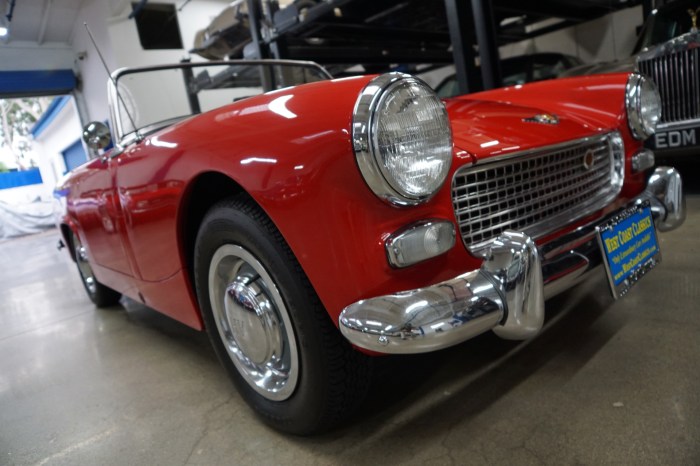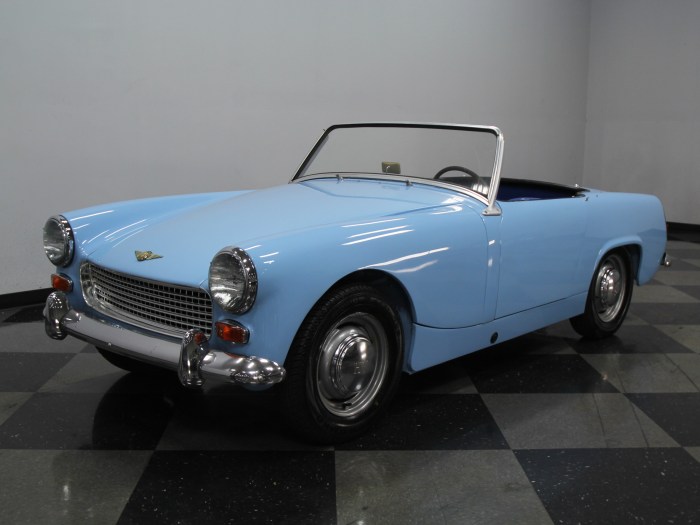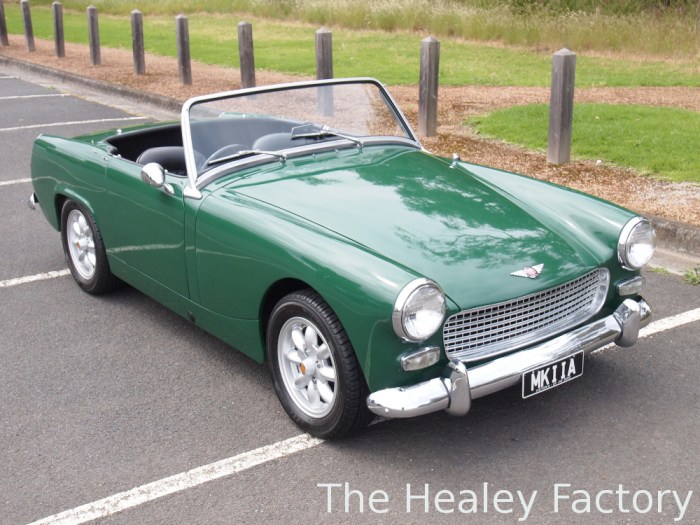The 1963 Austin-Healey Sprite, a compact British roadster, was a triumph of engineering and style, capturing the hearts of enthusiasts worldwide. This diminutive sports car, born from a collaboration between the Austin Motor Company and Donald Healey Motor Company, redefined the concept of affordable performance.
Its sleek design, agile handling, and spirited engine made it a true icon of the 1960s, a period when driving was more than just transportation; it was an adventure.
The Sprite’s impact was undeniable, resonating not just with drivers but also with popular culture. Its charming appearance and thrilling performance made it a favorite for movie appearances and even inspired a generation of car enthusiasts. The 1963 Sprite, despite its modest size, left a lasting mark on automotive history, a testament to the enduring appeal of classic British sports cars.
History and Background
![]()
The Austin-Healey Sprite, a small, nimble roadster, emerged in 1958 as a joint venture between the British Motor Corporation (BMC) and Donald Healey Motor Company. The 1963 model, while retaining the core design elements of its predecessors, incorporated significant refinements and enhancements.The 1963 Sprite was a testament to BMC’s commitment to affordable sports car ownership.
The 1963 Austin-Healey Sprite, with its diminutive size and sprightly performance, was a popular choice for enthusiasts seeking a fun and affordable roadster. The Sprite’s design lineage can be traced back to the 1954 Austin-Healey 100-4 , a larger and more powerful model that established the brand’s reputation for performance and style.
While the Sprite was a smaller and more affordable car, it retained the Austin-Healey’s commitment to driving pleasure and sporty handling, making it a timeless classic for enthusiasts.
It was conceived as a smaller, more economical alternative to the larger Austin-Healey 100/6 and 3000 models, targeting a wider market of enthusiasts. The car’s design philosophy centered around simplicity, lightweight construction, and agile handling, making it a thrilling and accessible entry point into the world of sports cars.
Design Philosophy and Key Features
The 1963 Sprite’s design reflected a blend of practicality and performance. Its compact dimensions, with a wheelbase of 80 inches, enabled exceptional maneuverability. The car’s lightweight construction, employing a steel monocoque chassis, contributed to its spirited performance. The Sprite’s distinctive styling, characterized by its low-slung profile, small grille, and rounded bodywork, captured the essence of a classic British roadster.The 1963 Sprite was powered by a 948cc four-cylinder engine, producing 48 horsepower.
This engine, derived from the BMC A-Series, was known for its reliability and fuel efficiency. The Sprite’s suspension, featuring independent front and rear units, provided a comfortable and responsive ride. The car was equipped with a four-speed manual transmission, which allowed for smooth and precise gear changes.
Comparison with Earlier and Later Austin-Healey Models
The 1963 Sprite, though smaller than its Austin-Healey siblings, shared a common design philosophy with the larger 100/6 and 3000 models. All three cars emphasized lightweight construction, agile handling, and a focus on driver engagement. However, the Sprite’s compact dimensions and more affordable price point positioned it as a distinct entry-level sports car.The 1963 Sprite differed from later models, such as the Mk II and Mk III, in several key areas.
The Mk II, introduced in 1964, featured a larger 1098cc engine, increased power output, and a redesigned front end. The Mk III, released in 1966, incorporated further refinements, including a more powerful engine, a wider track, and improved brakes.
The 1963 Austin-Healey Sprite, a compact and nimble roadster, embodies the spirit of classic British sports cars. Its design, a blend of practicality and performance, was inspired by the earlier, more powerful 1933 Austin-Healey Roadster , which featured a more robust engine and a longer wheelbase.
While the 1963 Sprite might lack the raw power of its predecessor, it offers a more accessible and playful driving experience, making it a beloved classic among enthusiasts.
Anecdotes and Stories, 1963 Austin-Healey Sprite
The 1963 Sprite’s introduction was met with enthusiasm from both the public and the automotive press. The car’s affordability and sporty nature made it a popular choice for young drivers and enthusiasts. One notable anecdote recounts a story of a Sprite owner who drove his car across the United States, demonstrating the car’s durability and reliability.
The Sprite’s compact dimensions and nimble handling also made it a popular choice for racing. The car achieved success in various motorsport events, including the SCCA National Championship. Its lightweight construction and potent engine made it a formidable competitor on the track.
Design and Engineering

The 1963 Austin-Healey Sprite, a small, sporty roadster, was a testament to British ingenuity and design prowess. It was a car that aimed to bring the thrill of open-top motoring to the masses, offering a blend of affordability, performance, and style.
The 1963 Austin-Healey Sprite, a nimble roadster, offered a taste of British sports car charm. While its compact size and peppy engine made it a joy to drive, some sought a more powerful experience. The 1967 Austin-Healey 3000 Mark III BJ8 represented a step up in performance , with its larger engine and refined handling.
Despite the differences, both models embody the spirit of open-air driving and a connection to classic British automotive heritage.
The Sprite’s design and engineering were key to its success, and it continues to be admired by enthusiasts today.
Exterior Design
The Sprite’s exterior design was characterized by its compact dimensions, lightweight construction, and distinctive styling cues. Its low-slung body, with its rounded front end and raked windshield, gave it a sporty and aerodynamic profile. The car featured a distinctive grille with horizontal slats, round headlights, and a small, upright windscreen.
The Sprite’s bodywork was made of steel, and its lightweight construction was achieved through the use of thin gauge metal panels and minimal interior trim. The car’s compact size and low center of gravity contributed to its agile handling and responsiveness.
Interior Design
The interior of the Sprite was designed to be simple and functional, with a focus on driver-centric ergonomics. The dashboard was uncluttered, featuring a centrally mounted speedometer and a small number of other gauges. The seats were simple and comfortable, providing adequate support for spirited driving.
The Sprite’s interior was spartan, with minimal sound insulation and limited storage space. This was a common feature of sports cars of the era, reflecting the focus on performance and lightweight construction.
Materials and Construction Techniques
The 1963 Sprite was built on a lightweight, monocoque chassis made of steel. This construction method, which integrated the bodywork and chassis into a single unit, was relatively new at the time and helped to reduce the car’s overall weight.
The body panels were made of thin-gauge steel, which was stamped and welded to form the car’s distinctive shape. The use of lightweight materials and efficient construction techniques helped to keep the Sprite’s weight down, contributing to its nimble handling and performance.
Engine Specifications and Performance
The 1963 Sprite was powered by a 948 cc, four-cylinder engine that produced 48 horsepower. This engine was a modified version of the one found in the Morris Minor, and it was known for its reliability and durability. The Sprite’s engine was paired with a four-speed manual transmission, which delivered power to the rear wheels.
The car’s relatively low weight and powerful engine gave it a lively performance, with a 0-60 mph time of around 14 seconds.
Handling and Driving Dynamics
The 1963 Sprite was renowned for its agile handling and responsive steering. Its low center of gravity, independent front suspension, and live rear axle provided a balanced and predictable driving experience. The car’s small size and lightweight construction made it easy to maneuver, and its quick steering response made it a joy to drive on winding roads.
However, the Sprite’s lack of power steering could make it somewhat tiring to drive in city traffic or on long journeys. The car’s suspension was also on the firm side, which could make it uncomfortable on rough roads.
Production and Sales

The Austin-Healey Sprite, a British roadster, was manufactured by the MG Car Company in Abingdon, England, and sold by the Austin Motor Company. The car’s production and sales were a testament to its popularity and enduring appeal.
Manufacturing Process and Production Volume
The 1963 Sprite was built on a modified MG Midget platform, sharing many components with its sibling. The manufacturing process involved a combination of traditional and modern techniques. The body was constructed using a combination of steel and aluminum, with the chassis being a welded steel frame.
The car’s assembly was streamlined, with many parts being pre-assembled before being incorporated into the final product. Production of the 1963 Sprite began in July 1961 and continued until 1966, with a total of 49,309 units being produced.
Cultural Impact and Legacy: 1963 Austin-Healey Sprite
![]()
The 1963 Austin-Healey Sprite, with its playful design and affordable price, became more than just a car; it embodied a spirit of youthful rebellion and freedom that resonated with a generation. Its impact transcended the automotive world, leaving an indelible mark on popular culture and inspiring enthusiasts for decades to come.
Impact on Popular Culture
The Sprite’s charming appearance and sporty performance made it a natural fit for the silver screen and the television. It appeared in numerous films and television shows, often portraying a carefree and adventurous lifestyle.
- In the 1968 film “The Thomas Crown Affair,” a Sprite is driven by Faye Dunaway’s character, symbolizing her independent spirit and love for the thrill of the open road.
- The Sprite also made a memorable appearance in the 1969 British comedy film “The Italian Job,” where it was used in a daring heist involving a Mini Cooper.
- In the 1970s television series “The Dukes of Hazzard,” a modified Sprite was featured as a “General Lee” look-alike, showcasing its versatility and appeal to a wide audience.
The Sprite’s influence extended beyond the visual media. It also became a popular subject in music, with its image often associated with a sense of rebellion and freedom.
- The 1960s British rock band The Kinks released a song titled “The Sprite,” highlighting the car’s popularity and its association with the youthful counterculture of the time.
- The Sprite also appeared in the lyrics of several other popular songs, further solidifying its cultural significance.
Notable Individuals and Organizations
The Sprite’s popularity attracted the attention of several notable individuals and organizations.
- The British racing driver Stirling Moss, known for his exceptional skills behind the wheel, was a vocal admirer of the Sprite’s performance and handling.
- The Sprite was also embraced by the British Motor Industry Heritage Trust, a non-profit organization dedicated to preserving the history of the British automotive industry. The Trust recognizes the Sprite’s significance as a key player in the success of the British car industry during the 1960s.
Enduring Appeal
Today, the 1963 Austin-Healey Sprite continues to hold a special place in the hearts of car enthusiasts worldwide. Its compact size, nimble handling, and distinctive styling make it a popular choice for classic car collectors and enthusiasts.
- The Sprite’s affordability and ease of maintenance make it a relatively accessible classic car, attracting a wide range of enthusiasts.
- The Sprite’s active community of owners and clubs provides a platform for sharing knowledge, restoring cars, and participating in rallies and events.
The 1963 Austin-Healey Sprite’s enduring appeal is a testament to its timeless design, its connection to a bygone era, and its ability to evoke a sense of nostalgia and adventure. It remains a cherished symbol of a time when driving was an experience, not just a means of transportation.
Visual Gallery

The 1963 Austin-Healey Sprite, a symbol of British sports car ingenuity, is more than just a vehicle; it’s a captivating visual experience. From its sleek design to its vibrant color options, the Sprite offers a captivating glimpse into the automotive aesthetics of the 1960s.
This gallery provides a visual journey through the Sprite’s evolution and enduring appeal.
Photographs of the 1963 Sprite
This section showcases the 1963 Sprite in various settings, capturing its essence from different angles.
- A pristine 1963 Sprite, gleaming in its original British Racing Green paint, stands proudly on a sunny day. The car’s iconic rounded bodywork and chrome accents are beautifully highlighted, showcasing the Sprite’s timeless elegance.
- A restored 1963 Sprite, painted in a vibrant shade of red, is captured on a winding country road. The car’s open-top design and sporty stance are evident, conveying the Sprite’s inherent sense of adventure.
- A 1963 Sprite, parked in a classic car show, draws admiring glances from onlookers. The car’s unique design and well-preserved condition make it a standout among other vintage vehicles, showcasing the Sprite’s enduring appeal.
Visual Timeline
This timeline traces the evolution of the Austin-Healey Sprite from its inception to the 1963 model, showcasing the design changes and technological advancements that shaped the Sprite’s iconic status.
- 1958:The Austin-Healey Sprite, initially known as the “Frogeye Sprite” due to its distinctive headlights, is introduced. This early model features a rounded bodywork, a small 948cc engine, and a four-speed manual transmission. The Sprite’s compact size and affordable price make it an instant hit, attracting a new generation of drivers to the world of sports cars.
- 1961:The Sprite undergoes a significant redesign, receiving a more angular bodywork, larger 1098cc engine, and a five-speed manual transmission. These changes enhance the Sprite’s performance and handling, further solidifying its reputation as a capable and fun-to-drive sports car.
- 1963:The 1963 Sprite, the subject of this gallery, is introduced. This model retains the angular design of its predecessor but features refined details, such as a revised grille and redesigned taillights. The Sprite’s popularity continues to soar, solidifying its place as a true British icon.
Ultimate Conclusion

The 1963 Austin-Healey Sprite remains a cherished symbol of a bygone era, a time when driving was an exhilarating experience. Its compact dimensions, nimble handling, and captivating design continue to captivate enthusiasts today. The Sprite’s legacy is a reminder of the timeless allure of classic sports cars, a legacy that continues to inspire and delight drivers of all generations.